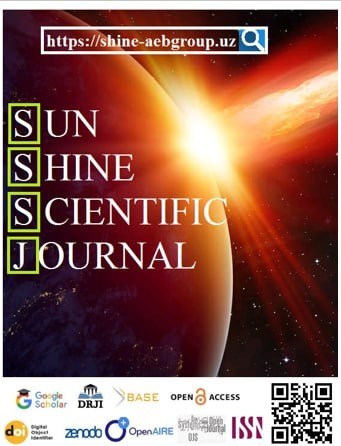1.4 INNOVATIVE TECHNOLOGY FOR CONDUCTING ENGINEERING AND GEODETIC SURVEYS OF RAILWAY AND AUTOMOBILE ROAD LINES
Abstract
Abstract:
The article presents the main ways of using unmanned aerial vehicles (UAV) in the field of construction , engineering and geodetic surveys and considers the prospects for expanding their functionality.
Key words:
UAV, aerial photography, drone, drone, multicopter, GEOSCAN, AutoCad.
ИННОВАЦИОННАЯ ТЕХНОЛОГИЯ ДЛЯ ПРОВЕДЕНИЯ ИНЖЕНЕРНО-ГЕОДЕЗИЧЕСКИХ ИЗЫСКАНИЙ ЖЕЛЕЗНОДОРОЖНОМ И АВТОМОБИЛЬНОМ ДОРОЖНОМ ЛИНИИ
Аннотация:
В статье приведены основные способы использования беспилотных летательных аппаратов (БПЛА) в сфере строительства , инженерно-геодезических изысканий и рассмотрены перспективы расширения их функционала.
Ключевые слова:
БПЛА, аэрофотосъемка ,беспилотник, дрон, мультикоптер, геоскан, AutoCad.
Using drone surveys can significantly reduce the cost of creating topographic and cadastral plans of the territory by reducing the amount of field work and the timing of their implementation. A helicopter-type UAV can shoot from 20 to 50 hectares of territory in a single flight, depending on the scale of the shooting, and an airplane-type UAV can shoot up to 20 square kilometers. At the same time, it is worth noting that the technology does not yet completely replace the work of a surveyor or cadastral engineer in the field. The amount of ground field work when performing UAV shooting will depend on the nature of the object and the underlying surface from shooting several points for control in the area of the UAV launch to conducting planned high-altitude training with a density of 4-5 points per square kilometer. In any case, the volume of field work in comparison with traditional shooting is reduced by 3-5 times[1.2.3.4.5.6].
Figure 1. Shooting with a drone.
General order of work:
- Obtaining permits for the use of air space and conducting AFS;
- Conducting planned high-altitude training at the facility;
- Aerial photography from UAVs;
- Processing of GNSS measurements, calculating coordinates of photography centers, checking materials at control points;
- Фото photogrammetric processing - building an orthophotoplane, digital terrain model, digital terrain model (under certain conditions), 3D terrain model, point clouds;
- import data to AutoCad;
- Decryption of orthophotoplans, vectorization of the planned part of orthophotoplans, obtaining elevation marks from a digital terrain model;
- Field inspection and additional survey using satellite geodetic equipment (if necessary);
- The construction of topographical plan of a given scale.
It consists in determining the coordinates of the temporary base station and points of planned altitude justification in the local coordinate system. The points of the state geodetic network and the geodesic network of condensation are used as the starting points of the planned and high-altitude justification. Before performing a fly-in, several ground-based identifications are installed and coordinated on the survey object. For 1 sq km of area shooting at a scale of 1:2000, 2-3 targets are sufficient, and 5-6 targets at a scale of 1:500. The base station for the duration of the flight is placed either at a point with known coordinates, or coordinated after.
Fig-2. Definitions of points on the map.
To achieve the maximum economic effect when performing surveys for engineering and geodetic surveys and cadastre, it is necessary to use high-performance drones with the maximum possible characteristics of the camera and an integrated satellite geodetic receiver. Aerostrim company uses domestic industrial drones for this purpose — GEOSCAN 101, GEOSCAN 201, GEOSCAN 401. Small objects use a self-developed Aerostrim 001 quadcopter with an integrated Sony RX-1 camera. The accuracy of the final product is up to 10 cm in plan and height. Preparing an airplane and copter type UAV for takeoff usually takes 10-15 minutes. To prepare a flight task, the planning program must specify the shooting boundaries, the resolution of the image on the ground (cm / pixel), the longitudinal and transverse overlap, as well as the landing point/wind speed measurement (for the aircraft). Flight planning is usually done in the office and adjusted on the spot according to the situation. The interface of the Geoscan Planner planning program is shown below. Aircraft-type UAVs are launched from a catapult, while copters are launched from any flat area.
The video below shows drone launches and the use of materials to control cadastral boundaries and ground mass volumes.
Fig-3. Aerial photography on the site.
After the flight is completed, images and log are downloaded from the GNSS receiver. The next task to be solved is to get the exact coordinates of the centers of photography. All used UAVs are equipped with two-frequency or single-frequency satellite receivers of geodesic class. During the flight, the onboard GNSS receiver writes the log and event of the camera shutter actuation. On an airplane, data is written at a frequency of 10 Hz. A high degree of synchronization between the camera and the receiver allows you to get timestamps in places where the camera shutter actually triggered. The received data is equated with the base station data and reference station data (if available). The accuracy of the coordinates of the centers of photography as a result of post-processing is usually a few centimeters in plan and height[7.8].
Figure 4. Photogrammetric processing.
Produced in Agisoft Photoscan Pro or similar. The initial data are loaded geodetic coordinates of the centers of photographing. Air defense points are used for monitoring.
Figure 5. Results of photogrammetric processing.
Photogrammetric point cloud in TXT (XYZ point cloud), LAS, and DXF formats. The point cloud can be unloaded at any density. Horizontal lines with a specified step, based on a dense cloud of points in any GIS or DXF format. The scale of the shooting 1:500, 1:1000, 1:2000.
Creating a topographic plan using aerial photography materials:
- Import an orthophotoplane to AutoCad;
- Getting terrain markers from the elevation map, importing them to AutoCad;
- Interpretation of the orthophoto, vectorization and creation of the planned parts of a topographic plan;
- Field inspection, additional shooting of elements that are not visible on aerial photography materials;
- The creation of a final topographic plan.
After receiving the orthophotoplane, the materials are imported to AutoCad, where vectorization is performed with the decryption of topographic objects. Apply the contour of land, fences, engineering structures, buildings and structures, and other visible elements of the topographic plan. Then, from the resulting digital terrain model (elevation map), the surface elevation points are imported in the format .txt to AutoCad format. After conducting field control and finishing shooting of elements that are not visible on aerial photography materials, the cartographer performs "finishing" drawing of the received materials in accordance with the norms for submitting topographic plans.
Fig. 7. Aerial photography in AutoCad format.
CONCLUSIONS
- When conducting aerial photography, the time spent on field work is reduced by 70-90 percent, depending on the complexity of the topographic survey area, which significantly reduces the cost of work.
- Laboratory work at the same time increase not much, but the quality of the drawing field of the material is improved.
- The accuracy of the obtained materials is not inferior to the work performed by the classical method of topographic or cadastral survey, and in some places (when obtaining terrain) and exceeds.
References
- Clarity from above PwC global report on the commercial applications of drone technology, 2016 (PwC Report on commercial applications of unmanned aerial vehicles in the world, 2016) [Electronic data]. – Mode of access: www.dronepoweredsolutions.com.
- Boyko A. Areas of application of drones [Electronic data]. – Mode of access: http://robotrends.ru/robopedia/oblasti-primeneniya-bespilotnikov.
- https://russiandrone.ru/publications/analiz-vozmozhnosti-ispolzovaniya-dronov-v-sovremennom-stroitelstve/
- Abdualiyev E.B., Eshonov F.F. New uses of culvert Construction. Design Taxi, Issue 2, 2020 year 149-152p.
- Abdualiev E. B., Embergenov A. B. /Case of waterproofing pipes on railways/ skills of the 21st century for professional activity /volume 2/Tashkent 2021/2/15/ 184-185 p.
- Abdualiev E.B., Abdukarimov A.M. Increase of productivity and reliability of control of rails. Architectural and construction science and period materials of the Republican scientific and practical conference part №. 2 T.: 2017y. 24-26p.
- Abdualiyev, E.B. (2019) "Research of surface condition of the rails rolling on sections of high-speed and high-speed train traffic, ," Journal of Tashkent Institute of Railway Engineers: Vol.15:Iss.2,Article14.Available at:https://uzjournals.edu.uz/tashiit/vol15/iss2/14
- Abdualiyev, E.B. (2019) "Research of surface condition of the rails rollingon sections of high-speed and high-speed train traffic," Journal of Tashkent Institute of Railway Engineers: Vol.15:Iss.3,Article4. Available at: https://uzjournals.edu.uz/tashiit/vol15/iss3/4








